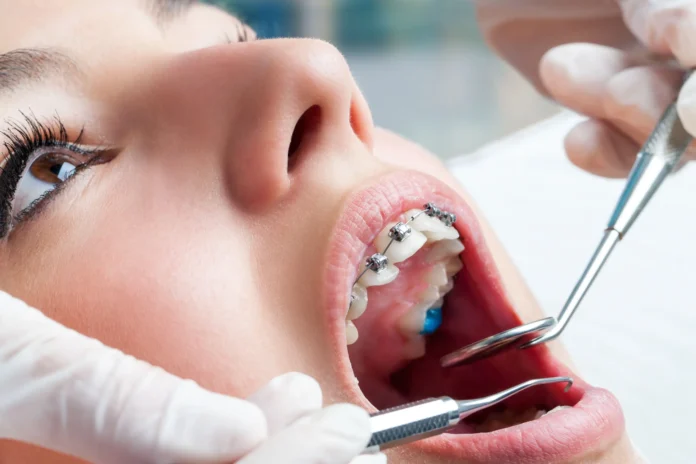Having straight, well-aligned teeth is important not only for a confident smile but also for maintaining good oral health. Crooked teeth can lead to difficulties in cleaning, affect your bite, and even lead to jaw discomfort over time. If you’re noticing misaligned teeth, it may be time to consider visiting an orthodontist for guidance. Here’s a look at when it might be the right moment to seek orthodontic care and what to expect from the experience.
Recognizing the Signs of Crooked Teeth
Crooked teeth can develop due to a variety of factors, including genetics, early loss of baby teeth, or habits such as thumb sucking during childhood. Recognizing the signs early can help you decide when to consult an orthodontist. Here are some common indicators:
- Overlapping or Crowded Teeth: When there’s not enough room in your jaw for teeth to align properly, they may start overlapping or crowding.
- Gaps Between Teeth: Some individuals may experience large gaps due to missing teeth or uneven spacing.
- Difficulty Biting or Chewing: Misalignment often leads to discomfort while eating, making it hard to chew properly.
Visiting an orthodontist in Udaipur can provide a personalized approach to assessing and treating any of these alignment issues, whether mild or severe.
Why Timely Orthodontic Treatment Matters
Taking timely action can prevent small alignment issues from developing into bigger problems over time. Crooked teeth can lead to:
- Improper Oral Hygiene: Misaligned teeth make it difficult to clean all surfaces effectively, increasing the risk of plaque buildup, cavities, and gum disease.
- Wear and Tear on Teeth: When your teeth don’t fit together correctly, you may put extra stress on certain areas, which can cause wear on the enamel and lead to chipping or cracking.
- Jaw Pain and Discomfort: Crooked teeth can sometimes result in an uneven bite, which may lead to jaw pain or temporomandibular joint (TMJ) issues.
By visiting an orthodontist, you can prevent these potential complications and maintain a healthier smile. They will evaluate your teeth alignment and suggest treatments to correct any issues before they progress.
Ideal Age for an Orthodontic Visit
Many people think of orthodontic care as something for teenagers, but treatment can start at any age. Here’s a guide to when an orthodontic evaluation is typically beneficial:
- Children (Age 7-12): Early intervention can sometimes make a significant difference. For children with noticeable alignment issues, an early visit can help guide the growth of the jaw and teeth. The orthodontist may recommend a two-phase treatment approach to address alignment issues early and fine-tune results as the child grows.
- Teens (Age 13-19): This is the most common age for orthodontic treatment since most or all adult teeth have usually erupted by this stage. Teens benefit from a variety of treatment options, from traditional braces to newer solutions like clear aligners.
- Adults (20 and Older): It’s never too late to seek treatment. Many adults visit an orthodontist to address long-standing alignment issues or to improve their smile. Modern orthodontic solutions cater to adults, offering discreet options like clear braces and aligners.
For residents in Udaipur, an orthodontist can provide guidance on the best age and options for treatment based on individual needs.
Types of Orthodontic Treatments for Crooked Teeth
There are several treatment options available, depending on the degree of misalignment and the patient’s preferences. Some common treatments include:
- Traditional Braces: These metal or ceramic brackets are a well-established method for gradually realigning teeth. Though more visible, they are highly effective for various alignment issues.
- Clear Aligners: For those seeking a less noticeable option, clear aligners are transparent and removable. They are especially popular among adults looking for a discreet solution.
- Retainers: After primary treatment, retainers are often used to maintain the corrected alignment and prevent teeth from shifting back to their original position.
Each treatment method has its own advantages and considerations, which can be discussed during an appointment with an orthodontist in Udaipur.
Preparing for Your First Orthodontic Appointment
Your first appointment with an orthodontist will involve an examination to assess your teeth and jaw alignment. The orthodontist may take X-rays, photographs, and impressions of your teeth to create a treatment plan tailored to your specific needs. During this initial consultation, you’ll learn about the available treatment options, costs, and expected duration of the treatment process.
It’s a good idea to prepare questions for the orthodontist, especially if you have concerns about comfort, appearance, or treatment duration. By discussing these factors, you’ll gain a clear understanding of how treatment can improve your smile and overall oral health.
Benefits of Addressing Crooked Teeth Early
Correcting misaligned teeth provides both cosmetic and functional benefits. With a well-aligned smile, you may notice improvements in your confidence and ease of maintaining proper dental hygiene. Additionally, by addressing alignment issues early, you’ll reduce the likelihood of developing further complications that could require extensive treatment down the road.
In Udaipur, consulting an orthodontist can help you explore options that align with your goals, allowing you to take a proactive approach to your oral health. Orthodontic treatments are tailored to fit each person’s unique situation, providing a path to a healthier and more confident smile.
Conclusion
Deciding when to visit an orthodontist for crooked teeth often depends on recognizing signs of misalignment and understanding the benefits of early treatment. By seeking guidance from a professional, you can prevent future issues, improve oral health, and achieve a well-aligned smile.



